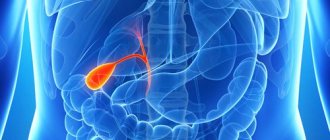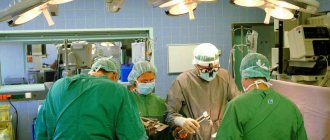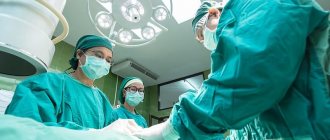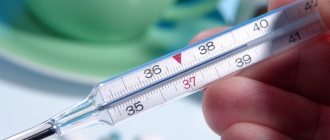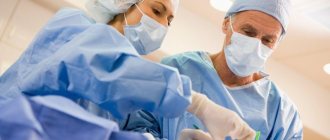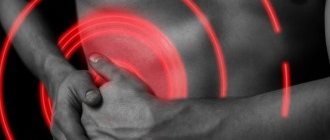Laparoscopic removal of the gallbladder (laparoscopic cholecystectomy) is a modern method of removing the gallbladder without wide incisions through several small punctures of the anterior abdominal wall. The operation is carried out using special manipulative instruments and an endoscope - a high-tech device with a video camera that transmits the image to the monitor screen.
Please note: laparoscopy to remove the gallbladder today is the “gold standard” in the treatment of gallstone disease. “Open” operations with a large incision are currently performed only when complications of cholelithiasis develop, including gallbladder perforation, peritonitis, and anatomical abnormalities.
In what cases is the gallbladder removed?
Your doctor may refer you for gallbladder removal surgery if you:
- Choledocholithiasis is a form of gallstone disease in which stones form in the lumen of the common bile duct
- Bile duct blockage
- Acute cholecystitis - if the disease occurs against the background of an existing gallstone disease, the doctor may decide on urgent surgery
- Gallstone disease (GSD) with attacks of biliary colic or with the manifestation of “minor” symptoms of the disease: bitterness in the mouth, aching painful sensations in the hypochondrium on the right and a feeling of heaviness after eating in the same area
- Asymptomatic gallstone disease
- Gallbladder calcification
- Gallbladder polyps with cholelithiasis or at risk of developing a tumor
- Perforation of the gallbladder - this disease can be caused by malignant tumors, severe abdominal trauma and a number of systemic diseases
- Cholesterosis – deposition of cholesterol on the walls of the bladder due to cholelithiasis
- Development of secondary pancreatitis
These are the main problems for which the gallbladder is removed. The extent to which removal is necessary in your case will be determined by your attending physician based on the results of a thorough preliminary diagnosis and your general condition.
It is important to know: if you do not perform the operation on time, sooner or later serious complications will arise that can cost you your life.
Therefore, do not delay your visit to the doctor. Make an appointment and undergo preliminary diagnostics.
Is it necessary to remove the gallbladder?
Why is the gallbladder necessarily removed? Can't you just remove the stones or polyps?
These questions worry most patients. Alas, you cannot leave the gallbladder because:
- Bile will interfere with the normal healing of the gallbladder wall after surgery.
- Bile can enter the abdominal cavity and cause peritonitis.
- Simply removing stones does not mean getting rid of cholelithiasis, since they form again.
- Even with successful healing of the gallbladder wall, a scar will remain in which bile particles will crystallize and stones will form.
- After surgery, adhesions often form that interfere with the normal release of bile, as a result of which it will stagnate, and this will sooner or later cause cholestasis.
Gallbladder removal surgery
With a traditional cholecystectomy, a fairly large incision of about 15-20 cm is made on the anterior abdominal wall, through which the gallbladder is removed.
Laparoscopy of the gallbladder has a number of advantages compared to traditional cholecystectomy:
- The gallbladder is removed through small, neat punctures instead of a large incision: after the operation you are left with almost imperceptible spots instead of an extensive scar
- You recover quickly: up to 2-3 days in hospital and up to 7 days outpatient
- Laparoscopy of the gallbladder occurs with virtually no blood loss
- The risk of complications after surgery (suppuration, formation of adhesions, etc.) is practically zero
- After surgery, you will need much less or no pain medication
Preparing for surgery
Preparation for surgery is the most important stage on which the success of the future operation largely depends. Preliminary diagnosis helps assess the general condition of your body, exclude infections, allergic reactions and other pathologies for which surgery is contraindicated.
These are the key tests and examinations you undergo before gallbladder removal:
- General and biochemical blood and urine tests.
- Tests for syphilis, hepatitis B and C.
- Coagulogram.
- Determination of blood group and Rh factor.
- Ultrasound of the gallbladder, biliary tract and abdominal organs.
- ECG.
- X-ray of the lungs.
- Fibrogastroscopy or colonoscopy – if necessary.
If necessary, other specialists are also involved for a comprehensive diagnosis - gastroenterologist, cardiologist, endocrinologist, allergist. This approach helps to understand your condition in detail, select anesthesia and properly monitor the body’s functioning during surgery.
How to prepare your bowels?
3 days before gallbladder laparoscopy, exclude bread, vegetables, and fruits. To cleanse the intestines, on the eve of the operation it is necessary to give an enema (about 1.5 liters of liquid) or take the drug Microlax.
The evening before surgery, you can eat a light dinner, for example, porridge or dairy products - cottage cheese, yogurt or kefir.
Important: Do not eat or drink for 8 hours before surgery.
How is the gallbladder removed?
Laparoscopy of the gallbladder is performed under general anesthesia and takes from 20 minutes to 1.5 hours:
- The doctor makes several small punctures in the abdominal wall and inserts instruments through them - trocars, an endoscope and special manipulators
- Gas is injected into the abdomen, which improves visibility
- The doctor clamps the cystic duct and artery with a special tool and cuts them off
- After this, the doctor removes the gallbladder from the abdominal cavity, removes the instruments and sutures the holes.
Sometimes a drainage (a thin tube to drain fluid) is installed in the wound, which is removed the next day if there is no discharge.
After removal of the gallbladder, you are transferred to the recovery room, where you are under the supervision of specialists for 1 to 3 days.
Life after laparoscopic cholecystectomy
The main thing you should remember when undergoing surgery is that after it you should feel like a healthy and happy person. To do this, you must follow a number of recommendations regarding diet and physical activity.
Diet for laparoscopic cholecystectomy: what is useful and what is harmful
During the 3 months of the postoperative period, patients must follow a strict diet, which was described above. Further, your diet and menu can be gradually expanded. But it’s worth remembering that if your gallbladder is removed, your diet will be your companion for the rest of your life. You can treat yourself to something tasty, but you shouldn’t overuse unhealthy foods.
The main rule is split meals in small portions.
List of products indicated for use:
- Fermented milk products: low-fat cottage cheese, kefir with befido additives;
- Cereal and milk soups;
- Weak broths (fish and meat);
- Lean meat (beef, chicken, rabbit, turkey);
- Eggs in the form of omelettes;
- Vegetable oil (no more than 25-30 g per day);
- Butter;
- Porridge;
- Pasta;
- Low-fat fish (stewed, boiled, steamed);
- Vegetables in raw, baked, boiled form;
- Honey, marshmallows, marmalade, dry cookies;
- Compotes.
- Sweet tea.
List of foods not recommended for consumption:
- fatty meats;
- Fried fish;
- mushrooms;
- strong coffee;
- spinach, onion, radish, garlic;
- sour berries and fruits;
- cakes, ice cream;
- carbonated drinks;
- butter dough, pasties, fried pies;
- spicy snacks.
After surgery to remove the gallbladder, drinking alcohol and smoking are strictly contraindicated .
Exercising – life in good shape after surgery
Daily physical activity is the key to good health, as well as a guarantee of avoiding bile stagnation. After one or two months, it is necessary to introduce weekly trips to the pool. Regular walking for 30-60 minutes will promote a comfortable outflow of bile, as well as the enrichment of body tissues with oxygen. This is especially important in the formation of normal metabolism and liver activity.
A few days after you start walking, you can introduce morning exercises. Over the next 6-12 months, heavy physical activity is absolutely contraindicated for patients, as this can cause the formation of a postoperative hernia. Intimate life can be resumed 1.5-2 months after the bladder is removed.
A couple of months after surgery, patients can and even need to start skiing. Skiing should be done at a calm pace.
A set of exercises for morning exercises
- Place your hands on your belt and place your feet shoulder-width apart. Move your elbows back - inhale, exhale and return your elbows to their original position. Eight to twelve repetitions should be done.
- Lying on your stomach, place your arms along your torso and legs together. We alternately bend our legs as we exhale and straighten them as we inhale. You should do six repetitions for each leg.
- Lying on your stomach, straighten your legs, left hand along your body, right hand on your stomach. While inhaling, we strongly protrude the stomach, while exhaling, we draw it in. The exercise should be repeated eight times.
- Lying on your side with your legs straight. Place one hand behind your head, the other on your belt. Bend the leg lying on top as you exhale, straighten it as you inhale. The exercise should be repeated at least eight (ten) times.
- Standing position, place your feet shoulder-width apart and bring your hands to your shoulders. We perform circular movements with our elbows 10 times forward and 10 times back. Breathe freely.
Preventative examinations with a doctor. Follow-up after gallbladder removal
After discharge from the hospital, do not neglect visiting a specialist for preventive examinations. It is recommended to visit a doctor at least once every six months in the first year after surgery, and once a year thereafter.
Attention! If you experience pain or discomfort after laparoscopic cholecystectomy, contact a specialist immediately.
Laparoscopic cholecystectomy is a modern operation to remove the gallbladder, the risk of complications after which is only 2-3%. After the operation, the patient must follow a diet and also perform a complex of gentle exercises necessary for the regular outflow of bile. Regular walks in the fresh air and visiting the pool are very important.
Reviews about laparoscopy of the gallbladder and life after it
The postoperative period is different for everyone. Some people opt for herbal medicine, others strictly follow a diet. Each patient’s story is a separate experience! If you want to share your experience of recovery, as well as give some recommendations to other people with a similar problem, leave your comment. Your information will be very useful to anyone interested in the topic of body recovery after laparoscopic cholecystectomy.
Source: postle50.com
Possible complications after surgery
In most cases, there are no complications after laparoscopy of the gallbladder, since there are no large incisions, stitches, and blood loss during the operation is minimal. But, like any surgical intervention in our body, this operation can cause a number of rare complications, including:
- Supuration of sutures
- Bleeding in the abdomen
- Leakage of bile
- Formation of adhesions
- Bile duct injuries during surgery
- Allergic reactions
- Thromboembolic consequences
- Exacerbation of another chronic disease
These complications are extremely rare. As a rule, this occurs in elderly people, or when there is severe concomitant pathology or severe damage to the biliary tract.
If you feel unwell after surgery, tell your doctor immediately, who will help prevent further complications.
Do stones form after gallbladder removal?
Surgery to remove the gallbladder does not change the composition of bile. Hepatocytes continue to create abnormal bile, which can cause stones to form again. That is why, even after surgery to remove the gallbladder, you need to regularly undergo bile composition testing.
Operation needed
The gallbladder stores bile, which is required to break down food into its components. Periodically, the organ becomes inflamed, causing discomfort, pain and pain. The patient is experiencing hellish torment and is ready to remove the pain in the hypochondrium by any means.
In addition to individual signs of disease (faculty classification of factors), disruption of the organ provokes jaundice, peritonitis, biliary colic, cholangitis. Such complications lead to surgical intervention.
Indications for surgery
The type of intervention when removing the gallbladder does not matter if the patient:
- Acute cholecystitis, chronic inflammation of the organ;
- Cholelithiasis;
- Polyposis;
- Cholesterosis;
- Functional disorders.
Gallbladder in humans
Cholecystitis
Cholecystitis is an inflammatory process. The wall of the gallbladder is subject to pathological processes in acute or chronic form. There may be a temporary improvement, then the organ relapses. Chronic cholecystitis provides grounds for elective surgery. Stagnation of bile is manifested by attacks of hepatic colic. Vomiting and nausea often accompany the disease. In case of acute inflammation with the presence of stones, urgent surgical intervention is required. Vomiting is accompanied by severe pain in the hypochondrium and a temperature of up to 38-39 degrees.
The chronic form of cholecystitis is the calculous type with a latent (hidden) course of the disease. Cholelithiasis is characterized by the presence of stones in the ducts or bladder. Treatment of the disease includes litholytic therapeutic procedures or cholecystectomy.
Cholelithiasis
The indication for cholecystectomy is cholelithiasis. Formations in the bladder provoke attacks of unbearable pain. Seventy percent of patients experience colic. The stones cause dyspepsia, heaviness in the abdomen, the right side hurts, and the skin acquires a yellowish tint. Concretions often lead to perforation of the organ and contribute to the development of peritonitis.
Gallstone pathology is eliminated in surgery as planned to avoid complications. The operation is accompanied by drainage of the ducts, since stones are often found in them. This disease is called choledocholithiasis. Blockage and inflammation of the bile ducts leads to the development of pancreatitis and obstructive jaundice.
Other diseases
With cholesterosis, the epithelial lining of the gallbladder becomes covered with cholesterol. The disease has no obvious symptoms and is discovered accidentally. The risk of malfunction of the gallbladder and the likelihood of organ damage are indications for surgical intervention. The disease is isolated and occurs as a stage of cholelithiasis. Older and overweight people are at risk.
Polyposis is fraught with the degeneration of polyps into malignant neoplasms. The reason for surgery is pedunculated polyps over 1 cm in diameter in combination with cholelithiasis.

Gallbladder cholesterosis
Rehabilitation after gallbladder removal
4-6 hours after gallbladder removal, you can eat light food, drink water, get out of bed and walk. The main thing is to do this carefully, as after anesthesia you may feel weak and dizzy.
Pain after surgery is minimal and does not require large amounts of analgesics. And many people do not need painkillers at all.
You will be discharged in 1-4 days. And in 15-20 days you will be able to return to work.
Limit physical activity: do not lift more than 2-3 kg and do not do exercises that involve the abdominal muscles.
Please note: proper nutrition after gallbladder removal is one of the most important factors in recovery.
Postoperative period
Any invasive procedures are always a huge stress for the patient, so the rehabilitation period will not be very easy and simple. Recovery will be faster if the operation was performed using a gentle method, that is, through laparoscopy. This minimally invasive intervention technique is less traumatic compared to midline laparotomy and helps to avoid serious consequences.
First of all, the patient needs to take into account that after the removal of the bile, the body will continue to function as before. The liver, as before, will secrete bile. It’s just that now it will not accumulate in the bile duct until the active digestive phase begins, but will continuously flow down the bile duct to the area of the duodenum. It is in this regard that the patient will have to adhere to a special diet, which should help protect the digestive system from constant bile secretion.
Many people are interested in how long rehabilitation after gallbladder removal lasts. A special diet is prescribed only in the first thirty days. Subsequently, it can gradually expand and be supplemented. After a few months, the patient will be able to eat almost anything. But still, you shouldn’t get carried away with fatty and spicy foods. And if possible, you should completely exclude them from your diet.
Such a patient will need at least one year to learn to do without this organ. During this period, its main function of accumulating bile will be performed by the bile duct and channels inside the liver, thanks to which the need for a strict diet will eventually disappear completely.
So, what is rehabilitation after gallbladder removal?
Nutrition after gallbladder removal
Without a gallbladder, bile constantly flows into the intestines from the liver. Proper nutrition will reduce its toxicity and help protect the intestinal mucosa.
For the first month after surgery, eat 5-6 times a day, but not much, and drink up to 1.5 liters of water per day. During this period, you can eat white bread, boiled meat and fish, porridge, jelly, fermented milk products, stewed or steamed vegetables.
Take your time and chew your food thoroughly: this will help activate the necessary enzymes and “turn on” the liver.
Six months after surgery, you can gradually expand your diet. Eat berries, fruits and vegetables, except onions, garlic, radishes and lemons. You can eat honey and dried fruits.
Alcohol, sweets, pickles, fatty and fried foods will have to be limited forever.
Fermented milk products with live bifidobacteria, which improve intestinal microflora, will also be beneficial for you.
If necessary, the doctor will prescribe choleretic herbs and medications with the necessary enzymes.
Drug treatment and gymnastics
After removal of the gallbladder, it is vital to restore normal functioning of the body and adapt all systems. To do this, the doctor will select individual drug therapy for you, consisting of choleretic and enzyme drugs, as well as drugs that restore intestinal microflora.
Several months after surgery, physical activity is necessary.
Several months after surgery, physical activity is necessary.
Take half-hour walks every day and do gymnastics in the morning. This will help saturate the body with oxygen and activate the abdominal organs.
Features of the operation
Removal of the gallbladder is performed under general anesthesia. The surgeon chooses how the organ will be cut off, based on the pathological processes, the severity of the patient’s condition and the hospital equipment. The method can be minimally invasive (laparoscopy, microaccess) or classical.
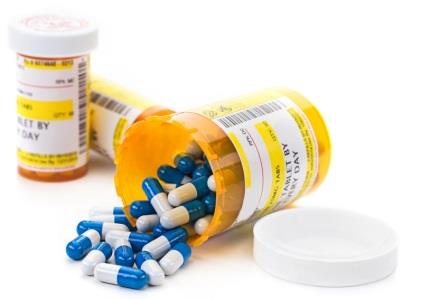
Abdominal surgery
Open surgery involves penetration along the midline of the abdominal cavity. The doctor may make incisions under the ribs. This method allows the surgeon to examine the biliary system, take additional measurements and sounding. The course of the classical operation follows the following scheme:
- The patient is placed on the table at an angle on his left side.
- Inspection of disease-affected areas at the site of abdominal excision.
- Stopping the outflow of bile by ligating the ducts. Clipping of blood vessels.
- Removal of the gallbladder, antiseptic treatment of the site of the organ.
- Suturing the incision after the doctor installs a drain.
Laparoscopy
Cholecystectomy is performed using this method more often than others. The operation allows you to monitor the progress of the manipulations. The abdominal organs are palpated instrumentally, which increases the level of safety. The patient's recovery is faster than after classic removal. Laparoscopic cholecystectomy causes less pain during the adaptation period, and the patient is ready to resume his usual way of life three days after the operation.
Stages of laparoscopy:
- Four punctures are made:
- In the area just above or below the navel;
- 2-3 cm below the xiphoid process in the midline;
- 3-5 cm below the costal arch along the anterior line of the armpit;
- Along the midclavicular line 2-3 cm below the ribs (right side).
- Providing visibility by injecting carbon dioxide.
- Compression and removal of the bile duct, cutting off the artery.
- After the gallbladder is removed, medical instruments are removed.
- Suturing surgical punctures.
The operation lasts from one to two hours, depending on the structural features of the body and the accessibility of the affected area. Before cutting off the organ, the stones are crushed into small pieces. After cholecystectomy, a drainage is placed in the hypochondrium to drain fluid.
Intervention with mini access
Laparoscopic surgery is not always indicated for patients. The minimally invasive method has become a salvation when it is impossible to use other methods. Mini access is a cross between laparoscopic intervention and classical surgery. Endoscopic surgery includes the following steps:
- Puncture;
- Ligation of the duct with the artery;
- Cutting off the gallbladder;
- Suturing the wound.
The incision is from 3 to 7 cm under the costal arch on the right. Mini access is indicated for patients with adhesions and inflammatory tissue infiltration. Rehabilitation after the intervention is easier than in the case of open cholecystectomy.
Removal of the gallbladder in the Stolitsa network of clinics means:
High tech
To effectively carry out low-traumatic operations to remove the gallbladder, we use modern premium PENTAX video equipment. Thanks to a powerful optical system, it allows the doctor to examine the condition of the gallbladder in detail and safely remove it.
Professionally
The experience and professionalism of the doctor is the key to a successful operation. After all, without a highly qualified specialist, even the most premium equipment is just devices. Only an experienced doctor can perform laparoscopic surgery professionally and safely for your health.
Over the years of successful practice, our specialists have performed a huge number of laparoscopic operations to remove the gallbladder and have restored health to hundreds of people.
By contacting us, you can be sure that our specialists will thoroughly understand your situation: they will conduct a detailed preliminary diagnosis and determine exactly how necessary it is to remove the gallbladder.
Before the operation, we enter into a formal contract with you. You receive all the necessary documents.
The contract price includes payment for the operation itself, the cost of anesthesia and postoperative observation in the clinic.
After the operation, you will receive a sick leave certificate from the first day of hospitalization, which you can extend if necessary either in our clinic or at your local clinic.
After discharge, you receive a discharge summary with a protocol of the operation and detailed recommendations from the doctor for treatment during the rehabilitation period.
When is it allowed to visit the bathhouse and go to the sea?
Many people wonder when it is possible to wash in a bathhouse or visit a sauna after laparoscopic interventions. These activities are authorized exclusively by a doctor after passing control tests. This is due to the fact that the bathhouse, as well as the sauna, is characterized by an increased temperature load on the body. There are times when high fever leads to internal bleeding. The same reason is an obstacle to sunbathing.

A trip to the sea should be discussed with your doctor
In addition, people are often interested in the question of how long it will take to go to sea after laparoscopy. Usually, doctors do not allow long-distance travel immediately after surgery, especially to hot countries. They claim that you can go to sea no earlier than 4 weeks after the procedure, provided you feel well and there are no serious complications.
In addition, before traveling, you must visit a doctor and undergo the necessary tests. If laparoscopy was performed on a woman for gynecological diseases, then gynecologists do not allow trips to the sea for six months. In this case, it is better to choose a different climate for relaxation that excludes direct exposure to sunlight. If you strictly follow all the doctor’s recommendations, you can avoid the development of complications. Particular attention must be paid to personal hygiene measures.
